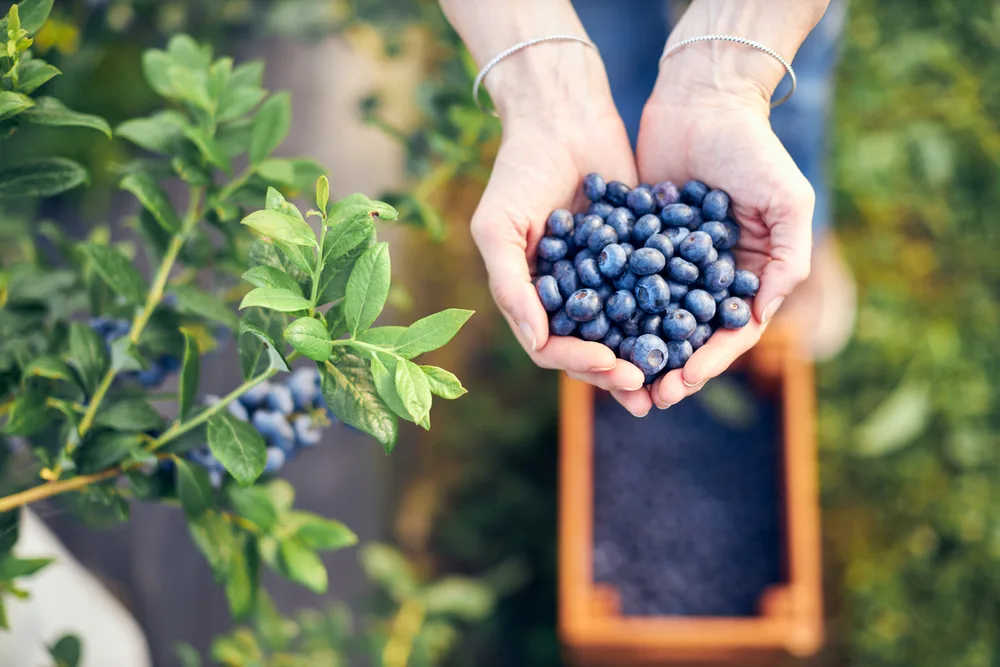These plants that love acid are the greatest companions for blueberries to help control pests naturally and increase the berry harvest.
Many gardeners want to grow juicy blueberries in their backyards but struggle to find plants that can grow in the acidic soil blueberries like.

Luckily, many colorful ornamental plants that love acid and tasty edibles make great companions for blueberries, and some even repel pests and boost the blueberry harvest.
If you grow blueberries in your garden or in small pots on a patio, consider adding some of the ten best companion plants for blueberries to thrive alongside your berries.
What Does Acidic Soil Mean?
Acidic soils have a pH level below 5.5 for most of the year. They are linked to various issues for plants and have high levels of aluminum and iron. Acidic soil is found in the humid northern temperate zone, where evergreens grow, and in humid tropics, which include savannah and tropical rainforests.
1. Strawberries
Strawberries and blueberries are often enjoyed together in smoothies and yogurt, but strawberries also make great companion plants for blueberries in the garden. Both berry plants like slightly acidic soil and prefer full sun and regular watering. Use low-growing strawberries as a border around taller blueberries, or plant strawberries with compact lowbush blueberries in a container garden.
2. Azaleas and Rhododendrons
Azaleas and rhododendrons thrive in acidic soils, making them ideal blueberry companions. Moreover, they typically bloom around the same time as blueberries, which can enhance pollination and improve the blueberry crop.
3. Alliums
Chives, onions, and ornamental alliums have a strong smell that repels many common garden pests. Alliums are popular for natural pest control in vegetable gardens and work well in berry patches too. Alliums deter Japanese beetles, deer, and aphids when used as companion plants for blueberries.
4. Native Wildflowers
Blueberry shrubs add structure and interest to native or woodland gardens, and you can further enhance your blueberry patch by growing native wildflowers nearby.
Plants like bee balm, coneflower, lupine, and columbine have similar growing needs to blueberries and planting them together streamlines your gardening tasks.
Additionally, native wildflowers attract pollinators to blueberry shrubs and improve the berry harvest.
5. Thyme
Like other strongly scented herbs, thyme repels pests, and its flowers attract beneficial insects. When grown as a companion plant for blueberries, thyme can attract parasitic wasps that help control blueberry pests. Some varieties, such as creeping thyme, are low-maintenance groundcovers that suppress weeds and add color to blueberry beds.
6. Basil
Basil is a light feeder that won’t compete with blueberries for soil nutrients. The shorter stature of basil plants means they won’t overshadow even lowbush blueberries.
Additionally, basil can adapt to slightly acidic conditions, and its scent repels some garden pests. If you enjoy experimenting with flavors, try using blueberries and basil to create tasty summer drinks or desserts.
7. Heather
Heather is an often overlooked ornamental plant, but it’s closely related to blueberries and has similar care requirements. Like blueberries, heather prefers well-draining, acidic soil and full sun. When in bloom, heather adds vibrant color to garden beds, and it’s attractive to bees.
8. Lemon Balm
Lemon balm is a fragrant herb that controls various garden pests and boosts pollinator activity. As a member of the mint family, lemon balm is easy to grow but tends to spread. To prevent lemon balm from taking over, grow it as a companion plant for blueberries in nearby pots.
9. Borage
Borage is often grown in vegetable beds because its flowers attract bees and predatory wasps. Besides being an excellent plant for pest control, some studies suggest that borage can improve the growth of nearby plants. As it grows, borage enriches the soil with trace minerals, potentially enhancing the disease resistance of neighboring plants.
10. Cranberries
Blueberries and cranberries have similar growing needs and are closely related plants. Some gardeners think cranberries need a water feature to grow, but water is mainly used to simplify harvesting in commercial cranberry crops. Cranberries aren’t aquatic plants; they can thrive in acidic garden beds and are suitable for container gardening.
